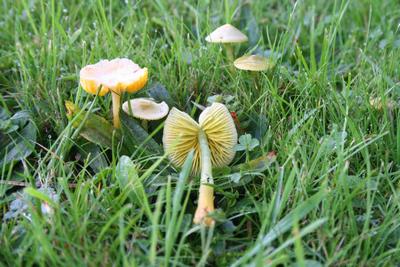 |
Parrot Waxcap |
Worcestershire Record No. 27 November 2009 pp. 26-30
by Sheila Spence
The Worcestershire Side of the Hills
Introduction
A survey of the fungi found on the Malvern Hills and Commons took place during 2007/8 to give an overview of both ‘what was out there’ and which were the best sites for fungi, in particular grassland fungi. At least one visit to the sites covered by the Malvern Hills Conservators (MCH) from the Wyche Cutting northwards was been made during the autumn of 2007 with the southernmost areas surveyed during the Autumn of 2008. It should be remembered, however, that fungi can only usually be identified whilst fruiting, which is often a very short space of time from a few hours to several days at the most, so there may well be several species which have not been recorded as they fruited outside the survey times.
The 2007 Survey
A full systematic field survey of each area was conducted covering each site so that within the time allowed all the MHC hills and commons were included. Some sites proved to be excellent for waxcaps and other grassland fungi whereas others held only very few records. This could be due to many reasons; fruit-bodies occurring earlier or later than the survey was conducted, traditional management of the area not conducive to the growth of fungi, in particular the length of the herbage and grazing/cutting regimes, weather conditions etc. Most areas were visited more than once during the Autumn/Winter each year.
Birches Farm
This site produced no records at all during the first visit but this was completely made up for during a visit at the end of October when 29 species of fungi were recorded, including a total of 13 species of waxcaps. Certainly the side of the field that runs alongside the Malvern Hills Outdoor Centre saw the greatest number of waxcaps, the other side of the field yielding far fewer specimens. Other grassland fungi such as Panaeolus and Entoloma species were also found in large quantities, together with many clusters of Golden Spindles, Clavulinopsis fusiformis but overall the quantities of waxcaps were the most notable.
Colwall Lands
The first visit here in July yielded three species of fungi, one being a particularly good edible fungus Calocybe gambosa, the St George's Mushroom. Later on in the year a further eight species of fungi were found, including four species of waxcap. None were very prolific but yet another good edible also cropped up; the Field Blewit, Lepista saeva. Although the field was being grazed by Galloway cattle there were still quite large areas of long grass which did not contain any fruit-bodies - and certainly made it harder to spot any that were there.
The Hacketts
The first visit to this site in July only gave one record, a rust on Sonchus, however about 27 species were recorded during the October visit including three species of waxcap. Although there were only three species of these good indicator species they were in high numbers in the field nearest the road, being found growing prolifically throughout several areas of the first field. The field away from the road, the far side of the hill, was very poor for fungi with only a few records and of those very few specimens found.
Also growing in quantity were Bolbitius vitellinus, the Yellow Fieldcap; a pretty yellow capped, white stemmed fungus which commonly grows on dunged ground, and Armillaria mellea, Honey Fungus, which was found growing well away from any of the trees but was perhaps most prolific in the area of grass just above the small line of trees half way up the first field. The mycelium of this fungus can run for a very long way and although usually associated with trees can be found, as in this case, growing many metres away from its 'host'.
Lodge Fields
This area of grassland did not produce many grassland species during the first visit, it did however have quite a list of fungi found on the fallen wood from a tree at the top of the field. Later in the year was much more fruitful when a large quantity of Hygrocybe conica, the Blackening Waxcap, was found near to the bottom field gate (SW) together with the Magic Mushroom Psilocybe semilanceata. Elsewhere in the field quite large quantities of waxcaps were also recorded including: the Parrot Waxcap; Hygrocybe psittacina; the Meadow Waxcap; Hygrocybe pratensis and the Ivory Waxcap; Hygrocybe virginea. In all 10 species of waxcap were recorded in this field, plus one that I have recorded as a H. virginea var. rosea which is presently under dispute as to whether or not it is actually a different species or carries an infection which makes the base of the stem pink.
 |
Parrot Waxcap |
Malvern Common
The larger area of common known as Malvern Common was surveyed in several visits and did not prove to be particularly interesting. A few waxcaps were found in an area to the south east of the common but only two species, the better area for fungi being just north west of the railway line where several species of waxcaps were found plus a wonderful display of Fly Agaric, Amanita muscaria, growing under what I believe is a Blue Cedar tree. There were several of these trees in this area but only one had fungi growing underneath it, in fact it had three species growing in profusion in the soil underneath it; Amanita muscaria, Fly Agaric, Boletus piperatus, Peppery Bolete and Collybia butyraceae, the Buttercap. The one fungus found in all areas of the common was Macrolepiota procera, The Parasol, a very large, elegant, fungus which grows in open grassland and renowned as being an easily recognisable good edible fungus.
Overall the common did not have as good a range of fungi and I had expected, considering the size and diversity of the site there were huge areas where no fungi were evident at all. Only one fungus that could be said to be prolific is Cystoderma amianthinum, the Earthy Powdercap, which seems to have had a good year almost everywhere.
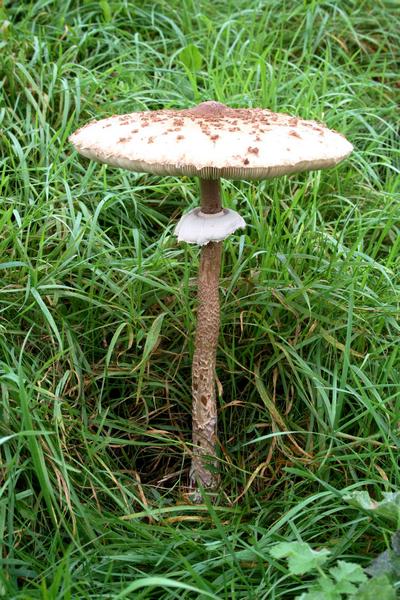 |
The Parasol
|
Malvern Link Common
This area did not give any interesting results this year with few grassland species and none of the amanitas and boletes recorded the previous year. Some of the lime trees along the road are showing signs of the Brittle Cinder fungus, Kretzschmaria deusta, (previously known as Ustulina deusta) which was recorded in 1966 just north of the Wyche at SO7745 one of only three records for the county.
Newland Common
Only one small area of the common showed any large amount of fungal interest and that was the area to the north east of the common, almost opposite the Swan public house. Here both waxcaps were found together with the three quite interesting species of Hebeloma.
One particularly interesting species recorded here was a fungus growing on a fungus; Paecilomyces marquandii, a lilac coloured mould growing on several specimens of Hygrocybe virginea - The Snowy Waxcap. It is as far as I can see otherwise unrecorded in both Herefordshire and Worcestershire so is a new county record for Worcestershire.
In all 23 records for this site but mostly in the northern end except for three small fungi growing on fallen Oak Quercus found not far from the bus stop area. The piece of fallen Oak branch was in a ditch and very wet and had three fungi growing on it, two very small cup fungi plus a slightly larger brown one; Humaria hemisphaerica. This fungus which grows on very wet rotting wood and soil has been recorded 19 times in Worcestershire mostly by M C Clark during the 1980's, but not before at this site.
Old Hills
Of the 26 species of fungi recorded on the Old Hills only 12 were grassland species, the rest growing either with or on trees, both living and as fallen wood or growing in soil/litter in association with trees. Of the grassland species there were three waxcap species in the grassy area above the grass car parking area going away from the road. Further up towards the trig point circles of Field Mushrooms, Agaricus campestris, were found showing a distinct dark ring where the fungus gives nourishment to the grass making it a darker and more 'lush' green.
The Malvern Hills, from the Wyche Northward
Starting at the Wyche Cutting and working northwards to ensure that each area of the hills was covered in turn. The first area showed no waxcaps at all during the first visit, but several other grassland species, including a wealth of Lycoperdon nigrescens, Dusky Puffball, with its very dark brown spiny covering, the small round Grey Puffball, Bovista plumbea, and the Meadow Puffball, Vascellum pratense. All these are types of puffball which get blown around in the windy places on top of the hills thus freely spreading their spores.
The only other species of particular note was the delightfully coloured Yellow Brain Fungus, Tremella mesenterica, which was during both visits growing on the living branches of Gorse bushes in several areas.
During the second visit in late November a few different species were found including a large crop of Hygrocybe laeta var laeta on the north facing side of this first hill almost on the saddle with Worcestershire Beacon itself. Two further waxcaps were recorded during this visit; Hygrocybe virginea, the Snowy Waxcap and Hygrocybe chlorophana, the Golden Waxcap but only a very few specimens of each. One unusual species found at this time was Octospora (Neottiella) rutilans, a tiny bright orange cup fungus growing in moss and not previously recorded in Worcestershire. There are just over 100 records of this fungus nationally, mostly under its previous name of Neottiella rutilans.
Once on the Worcestershire Beacon things changed, eight Entolomas (Pinkgills) and six waxcap species were recorded over the whole area plus many other grassland species mostly quite high up on the hill. One species of particular note, whilst not rare, only four records in Worcestershire on the British Mycological Society (BMS) database to date, one of which is in the Hollybush area of the Malvern Hills, is Clavulinopsis fusiformis. These Golden Spindles were found in the upper part of the gully area to the north west of the Worcestershire Beacon and was particularly large for this species. It is usually found growing in much shorter grass but was in this case growing with quite long grass and its bright yellow 'tongues' were considerably longer than normal; approximately 12-15 cms long rather than 5 - 8 cms found elsewhere. Some of the records pertaining to this site came from the West of England Quarry area so contain several species growing with or on wood rather than in grassland.
Moving northwards onto Sugar Loaf one of the interesting finds was a waxcap not previously recorded in Worcestershire; Hygrocybe persistens var konradii, the Persistant Waxcap. Whilst Hygrocybe persistens var persistens has been recorded once before in Worcestershire this particular var. is new to the County records. One record from this area, seen on the western side below the open hill and is very much tree based, is the Eutypa spinosa, a black encrusting fungus that grows on the bark of living Beech trees. It damages the bark and although it does not otherwise harm the tree by itself, causes enough weakness to the bark to let other fungi in which can cause harm to the tree. There are no records for Worcestershire for E. spinosa on the BMS database but again this may be due to a lack of competent recorders in the county or simply under-recording, there are just under 250 records nationally and mostly on Beech Fagus sylvatica.
Another species of note in this area was the amount of Panaeolus semiovatus, the Egghead Mottlegill, found growing in cow-pats. Whilst not a particularly rare fungus it is most probably very under-recorded as there is only one other record on the BMS database for Worcestershire and that is in the Wyre Forest, it is however recorded in the WBRC for Castlemorton Common but unfortunately is one of many not apparently sent in to the National database. To put this in perspective there are well over 1,000 records countrywide for this species. Whist this and some other species specialise in growing in old cow-pats, in the areas where there had been some fairly concentrated grazing there was no sign of any high quality grassland fungi, whereas other areas which had not been grazed at all had a richer wealth of species. This may not of course be down to the cattle dunging and thus enriching the soil but that these areas have different species of grasses.
Moving across to Table Hill there was little of any consequence on the hill itself but in the saddle between Table Hill and End Hill there was a good selection of waxcaps including Hygrocybe laeta var. laeta , the Heath Waxcap, which has only been recorded once before in the county. Also recorded in this area were two species of yellow spindles; Clavulinopsis helvola, Yellow Club and Clavulinopsis luteoalba, the Apricot Club. Clavulinopsis helvola has been recorded nine times in the county, a couple of times somewhere near the Gullet, whereas Clavulinopsis luteoalba has only been recorded once before, in 1997.
Hygrocybe reidii, the Honey Waxcap, was the only waxcap found on North Hill and that was just a very few specimens in one tight area on the eastern slopes just down from the top of the hill, in the wavy grass. There may have been more but it is extremely difficult both to find fungi in very long grass but also for them to grow and spread their spores freely. There was however a fair amount of Lycoperdon nigrescens, the Dusky Puffball, and just one specimen of Macrolepiota procera, The Parasol, on the western slopes.
End Hill proved to be quite a good area with a total of five different species of waxcap, including the unusual H. laeta var. laeta again and H. quieta, the Oily Waxcap (more for its smell than its feel!). This latter species has been recorded before on Castlemorton Common in 1962, there are only six records on the BMS database for Worcestershire.
Twenty-eight species in all were recorded on this last hill, on top of those recorded as on the saddle between End Hill and Table Hill. The three species of Clavulinopsis found there; Clavulinopsis fusiformis, Golden Spindles; Clavulinopsis luteoalba, Apricot Club and Clavulinopsis helvola, Yellow Club, were in great profusion with most across the north facing area just over the top of the highest point. Another interesting find in this area was Psilocybe coprophila growing in cow-pats and surrounding well-manured grass. Although there are over 600 records on the national database it does not appear to have been recorded in Worcestershire before, and has no English name.
The 2008 Survey
Following the successful survey of the fungi on the northern hills and commons within the Malvern Hills Conservators area a similar survey was carried out on the southern area of the hills and commons during 2008. Over 800 new fungus records were accumulated during 2008 (some 465 in 2007) with several rare and endangered species included amongst the finds.
Castlemorton Common
The survey started in August on Castlemorton Common from the Welland end. Following a long spell of prolonged rain the ground was pretty waterlogged and fruit-bodies which were in evidence did not last long in good condition. There were however very good quantities of several different species including Agrocybe cylindracea which was found growing at the base and around the roots of several of the large old Poplar trees lining the brook. In particular trees numbered 012388, 02331 and 02389, there was a large bracket fungus high up on a nearby, unnumbered, tree but too high up the trunk to identify. Also in large quantities were Parasol mushrooms, Macrolepiota procera, mainly seen in the area in front of the caravan field but in great profusion there. Also in this area were two different species of waxcap: Hygrocybe conica, the Blackening Waxcap, and Hygrocybe glutinipes, the Glutinous Waxcap.
Under the Oak trees there were many boletes, in particular Boletus chrysenteron, the Red Cracked Bolete. Due to the rain they were quite large and fleshy and again lots of them. There were just over 50 records for this small area of the common during that first visit which perhaps shows its enormous wealth of fungal interest. Castlemorton Common continued to provide large amounts of records throughout the year and several visits were made covering most areas of this large common. Another interesting site, also surveyed later the same day following a tip-off from a colleague, was a small triangle of ground surrounding the pond at Barnard’s Green. For such a small area there were 16 species records, several of them in connection with the Lime trees. Later in the year further surveys were conducted across the different parts of this large common and included 12 different species of waxcap, including the following:
Hygrocybe calciphillaAlso of note in this area were the large amounts of Clavulinopsis corniculata, the Meadow Coral, and a very small patch of the tiny black earth-tongues; Trichoglossum hirsutum. only recorded once before in Worcestershire.
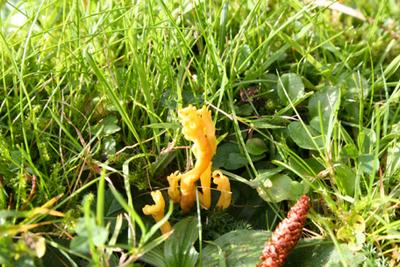 |
The Meadow Coral |
Black Hill and Brand Green
On 1st September the first visit to the Black Hill, Brand Green and Gardeners Quarry/Kettle Sings areas was made. A few Amanita species were seen in these areas, in particular Amanita rubescens and a few Amanita crocea. This latter, beautifully coloured orange fungus was seen several years ago growing in large quantities between the road and the Kettle Sings. However in recent years they have only been seen in ones and two, maybe because of the lack of grazing animals in this area. Also in the past there used to be many boletus species, including The Cep, Boleteus edulis, however we found no sign of them growing this year only a few Brown Birch Boletes, Leccinum scabrum, further along the roadside under the Birch trees.
Golden Valley
During September the waxcaps started appearing in large quantities both in numbers of fruit-bodies and different species. Even as early as 7th September, probably due to the high rainfall in previous weeks, there were 20 different species of waxcap recorded with the Golden Valley area:
Hygrocybe ceracea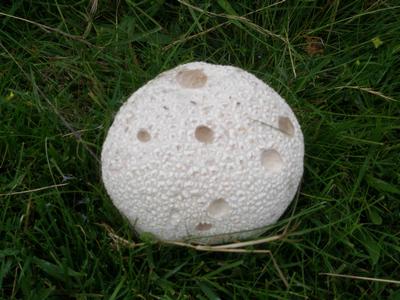 |
Mosaic Puffball |
Interestingly, in early November, much later in the year and when the majority of waxcaps could be expected to be still fruiting, only six different species of waxcap fungi were recorded over the same area. Whilst in this area we also looked at the small churchyard of the Church of All Saints, Hollybush where a wealth of interesting fungi were to be found on both visits, including nine species of waxcaps on the second visit on 2nd November when there were only the six species found in Golden Valley itself.
Herefordshire Beacon Area
On each occasion that this area was surveyed there were large amounts of fungi, not necessarily in species numbers, but certainly lots of fruit-bodies. The Pink Waxcap, Hygrocybe calyptriformis, was found on two occasions in the Hangman’s Hill area. The first occasion, on 24th September only two specimens were seen but on the second visit on 8th October there were many more in evidence, some having gone over whilst others were in prime condition. As far as I can ascertain from the records on the FRDBI managed by the British Mycological Society, there are no other records in this area for the Pink Waxcap. Fifteen species of waxcaps were recorded in this area during the survey visits, listed as follows:
Hygrocybe aurantiospendensLarge numbers of several species of waxcap and fairy clubs were recorded during the last visit to this site, on the northern most area dropping down from the top of the Herefordshire Beacon itself. There were large quantities of all three of the yellow fairy clubs; Clavulinopsis luteoalba, Apricot Club; Clavulinopsis helvola, Yellow Club and Clavulinopsis fusiformis, Golden Spindles, plus the Meadow Coral, Clavulinopsis corniculata. Broad Down held an array of grassland fungi including large quantities of the more unusual puffballs: Lycoperdon nigrescens and Bovista nigrescens plus the more common Bovista plumbea and Vascellum pratense. Also seen were many specimens of the Field Mushroom, Agaricus campestris and the Parasol, Macrolepiota procera which was seen both here and on nearby Hangman’s Hill.
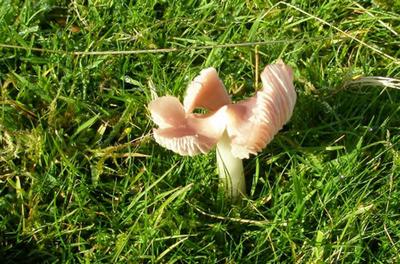 |
Pink Waxcap |
Hollybed Common
Eight different species of waxcap were recorded on Hollybed Common during the survey visit of 2nd November, including the Pink Waxcap, Hygrocybe calyptriformis. All four Clavulinopsis species were recorded; C. corniculata, fragilis, helvola and luteoalba plus a quite rare Earthtongue, Geoglossum glutinosus. This unusual Earthtongue is identifiable by its glutinous outer surface, just a few fruit-bodies being found in one small patch. Earthtongues are probably more common than they appear to be recorded due to the great difficulty in finding these tiny black, very simple, fruit-bodies in the surrounding moss and grass. This particular species does not appear to have been recorded before in Worcestershire as far as I can tell from the FRDBI.
White Leaved Oak & Chase End
This area of the Malvern Hill might have been expected to show more fungal diversity than it did due to its relatively unpopulated state. However, only six different species of waxcaps were found although other fungi were more in evidence. Waxcaps found here are as follows:
Hygrocybe ceracea
Collybia butyracea, the Buttercap, and Clitocybe clavipes, the
Club Foot were both found growing in grass and in profusion. These are normally
thought of as woodland species but have been found quite commonly throughout the
area growing in open grassland.
Conclusion
Overall a very high number of records have been collected during the fungus survey of the southern hills and commons on behalf of the Malvern Hills Conservators. Of these a large proportion are for waxcaps and other high conservation value grassland species. In fact 223 of the records collected were for waxcaps, of which there were some 33 different species. This puts the Malvern Hills and Commons into the classification of national importance for its diversity of grassland fungi in an area of high conservation value. Following Rald’s method of defining the conservation value of grassland it proves itself on waxcaps alone, but has the added benefit of two different earth-tongues and four species of Clavulinopsis to add to its value.
Focussing on Waxcaps
The list below gives the number of records on the BMS national database for Waxcap (Hygrocybe) species previously found in Worcestershire to help give some idea of the importance of the Malvern Hills and Commons for waxcap fungi recorded during 2007/8. Note that the above survey records have not yet been included in any databases so are not included in the numbers.
| Hygrocybe aurantiosplendens | 2 | ||||
| Hygrocybe calyptriformis | 27 | ||||
| Hygrocybe cantherellus | 2 | ||||
| Hygrocybe ceracea | 13 | ||||
| Hygrocybe chlorophana | 26 | ||||
| Hygrocybe coccinea | 17 | ||||
| Hygrocybe conica | 24 | ||||
| Hygrocybe glutinipes var glutinipes | 2 | ||||
| Hygrocybe insipida | 4 | ||||
| Hygrocybe irrigata | 5 | ||||
| Hygrocybe laeta var laeta | 1 | ||||
| Hygrocybe marchii | 0 | ||||
| Hygrocybe mucronella | 4 | ||||
| Hygrocybe nitrata | 2 | ||||
| Hygrocybe persistens var persistens | 1 | ||||
| Hygrocybe pratensis var pratensis | 18 | ||||
| Hygrocybe psittacina var psittacina | 23 | ||||
| Hygrocybe punicea | 10 | ||||
| Hygrocybe quieta | 6 | ||||
| Hygrocybe reidii | 8|
Hygrocybe russocoriacea
|
6
|
Hygrocybe virginea var virginea
|
27
|
|
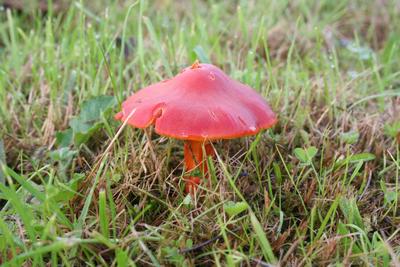 |
|
This report was put together by Sheila Spence following the survey of fungi, in particular grassland fungi, on the Malvern Hills during 2007 and 2008.
Surveying and recording was carried out by Sheila and George Spence. All identification was carried out by Sheila Spence using the following books and field guides:
| BOERTMANN, DAVID - The Genus Hygrocybe | |
| BON, MARCEL - The Mushrooms and Toadstools of Britain and North-Western Europe | |
| BREITENBACH J. & KRANZLIN F. - The Fungi of Switzerland (Books 1 - 6) | |
| JORDAN, MICHAEL - Encyclopedia of Fungi of Britain and Europe | |
| PHILLIPS, ROGER - Mushrooms |
Taxonomic orders are shown in accordance with the British Mycological Society guidelines. Some names may differ from those quoted in previous databases where they have been changed by the BMS, however the most up-to-date names have been used where possible.
Sheila Spence - Field Mycologist, Porcini, 12 Golding Way, Ledbury HR8 2PN
| WBRC Home | Worcs Record Listing by Issue | Worcs Record Listing by Subject |